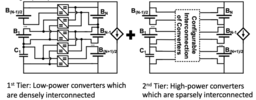Power Processing for Energy Storage
TECHNOLOGY NUMBER: 2020-122

OVERVIEW
A method for sparse power processing with dynamic configurability for heterogeneous energy storage systems- Improves power conversion efficiency through the use of differential power converters
- Provides 98% power conversion efficiency while requiring fewer converters per battery
BACKGROUND
Heterogeneous energy storage systems combine multiple types of energy storage devices to achieve optimal performance and efficiency. These systems can include batteries, supercapacitors, and other energy storage technologies, each with their unique characteristics, such as energy density, power density, and cycle life. By combining these different energy storage technologies, heterogeneous energy storage systems can provide a high level of flexibility, allowing them to address different energy storage requirements and applications. Additionally, these devices can reduce the overall cost of energy storage by combining lower-cost, higher-power storage devices with higher-cost, higher-energy density devices.
As the demand for renewable energy sources continues to grow, heterogeneous energy storage systems have become increasingly important, as they can help to address the intermittency and variability of renewable energy sources, improve grid stability, and reduce carbon emissions. However, heterogeneous systems pose several implementation challenges compared to ones in which only a single type of battery is used. Oftentimes, existing control techniques which charge and discharge different batteries cannot account for electrochemical or mechanical differences between them, so a need exists for new technologies to overcome these challenges.
INNOVATION
Researchers from the University of Michigan have developed a method for sparse power processing with dynamic configurability for heterogeneous energy storage systems. This technology improves power conversion efficiency through the use of differential power converters, given that it can intelligently adapt to the characteristics of different types of energy storage devices, such as batteries and supercapacitors. The interconnection is dynamically configurable to obtain the optimum arrangement of converters, resulting in a sparse topology that only activates the necessary components for a specific application. Within this context, differential power processing (DPP) is an energy conversion architecture that overcomes current mismatch from different batteries, thereby increasing power conversion efficiency and system reliability.
The sparse topology and the differential power processing help reduce the number of converters needed and improve power conversion efficiency, respectively. The inventors demonstrate a power conversion efficiency of approximately 98%, and the number of converters required is fewer than the number of batteries, improving system optimization. The invention can also be applied to the growing market of energy storage systems built with used (second-life) electric vehicle batteries. Overall, this approach has significant potential for improving the efficiency of energy storage systems and enabling the wider adoption of renewable energy sources.
PATENT APPLICATION
Number:17/497,680
-
expand_more mode_edit Inventor (2)Al-Thaddeus AvestruzXiaofan Cui
-
expand_more library_books References (1)
- Cui X, et al. , Lite-Sparse Hierarchical Partial Power Processing for Parallel Batteries in Heterogeneous Energy Storage Systems. 2021 IEEE 22nd Workshop on Control and Modelling of Power Electronics (COMPEL), 2021, pp. 1-8, doi:https://doi.org/10.1109/COMPEL52922.2021.9645943
-
expand_more cloud_download Supporting documents (1)Product brochurePower Processing for Energy Storage.pdf